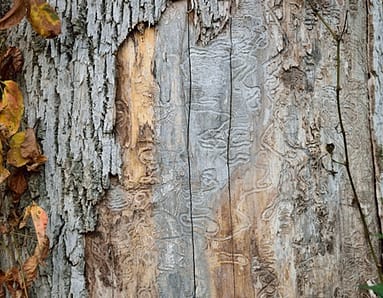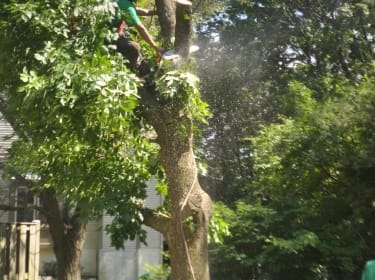If you spot an emerald ash borer beetle, or believe you have an infestation, you may need ash tree removal from an experienced tree removal service.
What Does the Emerald Ash Borer Beetle Look Like and How Is It Affecting My Ash Tree?
While it is difficult to spot the larvae of the emerald ash borer, because they live only inside of the ash tree’s bark, the adult emerald ash borer beetles are a bright, metallic green and emerge from beneath the bark in late May through mid-July. The beetles never stray far from the tree and cause little harm to the tree after they are full grown. It is crucial to know what the beetle looks like so you can know if you need ash tree removal services.
To learn more about the emerald ash borer’s appearance, read this article.
 Signs That You May Need Your Ash Tree Removed
Signs That You May Need Your Ash Tree Removed
There are many ways to identify the presence of an EAB infestation without directly seeing the larvae or even the beetle itself.
- Woodpeckers- The only known predator to the emerald ash borer beetle in North America is the woodpecker. An unusual or abundant presence of woodpeckers around your ash tree could indicate an infestation.
- S-shaped Larvae Galleries- These are a result of larvae feeding on the ash tree and the unique pattern is a distinct indicator of the emerald ash borer beetle’s presence.
- D-shaped Holes in Bark- Another distinctive identification is the holes that the larvae make when they emerge from underneath the bark, though they are not visible until a later stage of infestation.
- Dead Branches- As the emerald ash borer beetle eats away at the inside of the ash tree, preventing the flow of nutrients to the tree’s branches, you will begin to see these branches die beginning at the top of the canopy.
- New Branches at the Base- As the ash tree tries to fight off the infestation and prevent itself from dying, it may attempt to grow new branches at its base, where it is still able to reach nutrients.
- Vertical Bark Splits- As the tree dies, it’s bark may split as a result of the larvae feeding and moving underneath. If you look under these bark splits, you may be able to see the larvae.








